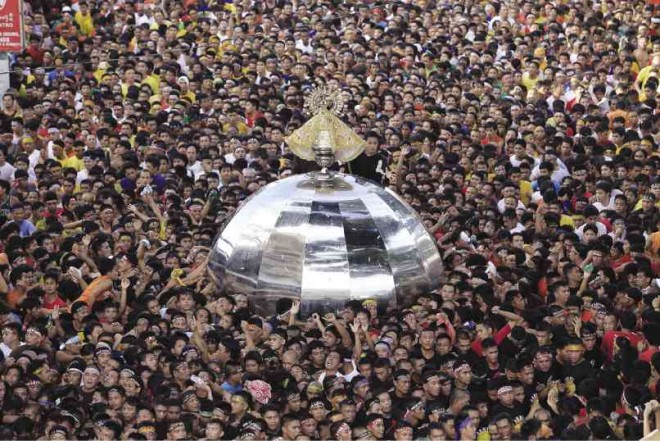Healing power draws devotees to ‘Ina’

THOUSANDS of pilgrims joined the annual fluvial procession of the Our Lady of Peñafrancia locally named “Ina” in Naga City on Sept. 19. The fluvial procession ends the novena feast of the city. The image of Ina is carried in a decorated shrine-barge called pagoda, with ropes tied in boats to return its journey to the Basilica Minore, where Pontifical Mass is held. MARK ALVIC ESPLANA
WHETHER it’s faith or a streak of animism, thousands of devotees are drawn to Naga City in Camarines Sur province to pay homage to the Our Lady of Peñafrancia, or “Ina.” Many believe in the healing power of the 305-year-old image of the Bicol patroness, whose feast is celebrated in September.
Two days after the fluvial procession on Sept. 19, the culmination of the nine-day regional fiesta of Ina, hundreds aboard buses and jeepneys still flocked to the Basilica Minore, Ina’s permanent residence, or days after the image was brought back from the Naga Metropolitan Cathedral during the novena.
Emelita Bagamasbad, 60, a devotee, traveled for almost two hours from Ragay town in a rented jeepney to reach the grounds of the basilica past
9 a.m. on Tuesday and join the queue of about a hundred people. She waited for more than 30 minutes for her turn to touch and wipe with a handkerchief the image of Ina on the altar.
After fulfilling that wish, she prayed the rosary, the inner calm nurtured by the belief that she and her loved ones will be protected year-round. The “blessed” handkerchief would be placed on a small altar in her house, to be used only for healing of body pain and unwashed lest the healing power will be gone.
Article continues after this advertisementBagamasbad has been following this routine for almost 20 years.
Article continues after this advertisementAnother devotee, Purita Lacroa, 46, who comes from the neighboring town of Pili, prefers to visit Ina after the nine-day religious fiesta when traffic had already eased and the crowd had dwindled.
‘Traslacion’
This year, the festivities began on Sept. 11 with the “traslacion,” the first ritual in which barefoot male devotees (“voyadores”) brought the image to the Naga Metropolitan Cathedral for the novena in a procession. The culminating activity on Sept. 19 was a colorful fluvial parade in the Naga River to return the image to the Basilica Minore.
Originally devoted to the “cimmarones” more than three centuries ago, the original image of Ina was carved from a santol tree in 1710, according to church history. The Spaniards tagged the lowland natives who fled from their colonial rule the derogatory term cimmarones.
The cimarrones lived on the shoulders of Mt. Isarog for years until a Spanish friar, Miguel Robles de Covarrubias, convinced them to come down and live again in the lowlands under the Spanish rule. In exchange, the friar gave them the Our Lady of Peñafrancia as their patroness.
Claiming ownership to the original devotion, the cimmarones under the direction of Robles de Covarrubias asked an artisan to carve the image of the Nuestra Señora de Peñafrancia from a picture the friar kept. According to church annals, the friar, a firm believer of the Our Lady of Peñafrancia, was healed from a serious illness.
First miracle
Robles de Covarrubias also instructed the cimmarones to build a chapel made of nipa and bamboo beside the Naga River where a dog was killed for its blood to darken the image. It was said that the dead dog was thrown into the Naga River but came back to life, supposedly witnessed by many people. It was considered the first miracle of Ina.
Fr. Ferdinand Operio, who works in the office of the Archbishop of Caceres, said the difference with the Peñafrancia Festival from other religious-themed feasts was that the visitors coming from the different towns of Bicol and even outside the region are all pilgrims paying homage (“sungko”) to the patroness.
Damian Bresnan, an American in his early 50s who has been residing in Naga for 16 years with his Filipino wife from the city, professed his devotion to Ina by joining the traslacion procession in a white shirt with the image of the patroness and walking shorts. Around his head was a white ribbon with the words “Viva La Virgen.”
Bresnan said he was introduced to the devotion in 1999.
In 2010, President Aquino issued Executive Order No. 33 declaring Naga and Camarines Sur as pilgrimage capital of Bicol.
The move aimed to conserve, promote and popularize the historical and cultural heritage of the devotion to the Our Lady of Peñafrancia.
It also formally declared the Feast of Our Lady of Peñafrancia as the only regional feast in the country.